
Birds in flight can be a particularly challenging aspect for any birder, but especially to novice birders. My image of a male lesser goldfinch from the walk last Saturday shows a very bold pattern. Note the large white patches in the primary feathers of the wing and the extensive white patches in the tail. Also note the dark terminal band in the tail which forms a “T” with the dark central part of the tail. Both male and female American Goldfinches and female lesser goldfinches do not show such a strong or similar pattern compared to the male lesser goldfinch. When perched, the large primary patch of the male lesser shows as a rectangular mark on the wing. When you observe a flying male lesser goldfinch, the white wing patch looks more like a broad white stipe down the center of the wing because of the movement of the wing. Only with the stop action of a camera do you see what looked like a stripe in flight is actually a patch. No other small yellow bird shows such extensive white in the wing and tail in flight than a male lesser goldfinch. Also note that the image, like most in flight shots, is backlit and that can change the pattern and coloration of the wing and tail. For example, red-tailed hawks when observed perched most often show whitish undertail coloration and reddish color on the dorsal view of the tail. When they are in the air, you often see a reddish tail from below because of the backlighting. In other words, the red color from the top shines through the tail. Lighting can play funny tricks and you should always be aware of the conditions when out birding.